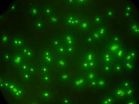(Press-News.org) CHAMPAIGN, Ill. — Researchers have developed a simple method of making short protein chains with spiral structures that can also dissolve in water, two desirable traits not often found together. Such structures could have applications as building blocks for self-assembling nanostructures and as agents for drug and gene delivery.
Led by Jianjun Cheng, a professor of materials science and engineering at the University of Illinois, the research team will publish its findings in the Feb. 22 edition of the journal Nature Communications.
Materials scientists have been interested in designing large polymer molecules that could be used as building blocks for self-assembling structures. The challenge has been that the molecules generally adopt a globular, spherical shape, limiting their ability to form orderly aggregates. However, polypeptides – chains of amino acids such as proteins – can form helical structures. Short polypeptide chains that adopt a spiral shape act like cylindrical rods.
"If you have two rigid rods, one positive and one negative, right next to each other, they're going to stick to each other. If you have a way to put the charge on the surface then they can pack together in a close, compact way, so they form a three-dimensional structure," Cheng said.
However, it is difficult to make helical polypeptides that are water-soluble so they can be used in solution. Polypeptides gain their solubility from side chains – molecular structures that stem from each amino acid link in the polypeptide chain. Amino acids with positive or negative charges in their side chains are needed to make a polypeptide disperse in water.
The problem arises when chains with charged side chains form helical structures. The charges cause a strong repulsion between the side chains, which destabilizes the helical conformation. This causes water-soluble polypeptides to form random coil structures instead of the desired helices.
In exploring solutions to the riddle of helical, water-soluble polypeptides, researchers have tried several complicated methods. For example, scientists have attempted grafting highly water-soluble chemicals to the side chains to increase the polypeptides' overall solubility, or creating helices with charges only on one side.
"You can achieve the helical structure and the solubility but you have to design the helical structure in a very special way. The peptide design needs a very specific sequence. Then you're very limited in the type of polypeptide you can build, and it's not easy to design or handle these polypeptides," Cheng said.
In contrast, Cheng's group developed a very straightforward solution. Since the close proximity of the charges causes the repulsion that disrupts the helix, the researchers simply elongated the side chains, moving the charges farther from the backbone and giving them more freedom to keep their distance from one another.
The researchers observed that as they increased the length of the side chains with charges on the end, the polypeptides' propensity for forming helices also increased.
"It's such a simple idea – move the charge away from the backbone," Cheng said. "It's not difficult at all to make the longer side chains, and it has amazing properties for winding up helical structures simply by pushing the distance between the charge and the backbone."
The group found that not only do polypeptides with long side chains form helices, they display remarkable stability even when compared to non-charged helices. The helices seem immune to temperature, pH, and other denaturing agents that would unwind most polypeptides.
This may explain why amino acids with large hydrophobic side chains are not found in nature. Such immutability would preclude dynamic winding and unwinding of protein structures, which is essential to many biological processes. However, rigid stability is a desirable trait for the types of applications Cheng's group explores: nanostructures for drug and gene delivery, particularly targeting cancerous tumors and stem cells.
"We want to test the correlation of the lengths of the helices and the circulation in the body to see what's the impact of the shape and the charge and the side chains for clearance in the body," Cheng said. "Recent studies show that the aspect ratio of the nanostructures – spherical structures versus tubes – has a huge impact on their penetration of tumor tissues and circulation half-lives in the body."
Cheng plans to create a library of short helical polypeptides of varying backbone lengths, side chain lengths and types of charge. He hopes to simplify the chemistry even further and make the materials widely accessible. His lab already has demonstrated that helical structures can be effective gene delivery and membrane transduction agents, and building the library of soluble helical molecules will allow further investigation of tailoring such nanostructures for specific biomedical applications.
INFORMATION:
The National Science Foundation and the National Institutes of Health supported this work. Illinois co-authors were graduate students Hua Lu and Yugang Bai and undergraduate student Jason Lang. "Hua Lu, a fifth year graduate student in my group, is the first author of the publication and made the most significant contribution to this work," Cheng said. Yao Lin and Jin Wang, of the University of Connecticut, and professor Shiyong Liu, of the University of Science and Technology of China, also collaborated with Cheng's group on the paper.
Simpler way of making proteins could lead to new nanomedicine agents
2011-02-24
ELSE PRESS RELEASES FROM THIS DATE:
Semporna may have richest marine biodiversity in the world
2011-02-24
The preliminary results of the Semporna Marine Ecological Expedition (December 2010) indicate that Semporna may have the world's highest marine biodiversity. The expedition yielded a record number of 43 species of mushroom corals. Furthermore, some new species were discovered, among which at least two shrimps and possibly a number of gall crabs. The health of the reefs was judged to be relatively poor: 36% of the transects had fair, another 36% had poor live coral cover. Eighteen scientists from Malaysia, the Netherlands and the USA spent three weeks examining the reefs ...
Review highlights need for more education and guidance on CAM use in midwifery
2011-02-24
Complementary and alternative medicine (CAM) is increasingly popular in maternity care, but healthcare professionals need formal evidence-based education and guidance about its use, according to a review in the March issue of the Journal of Advanced Nursing.
There is also need for greater respect and cooperation between conventional and alternative practitioners and improved communication with patients about the growing use of CAM.
University-based members of the Network of Researchers in the Public Health of Complementary and Alternative Medicine (NORPHCAM) reviewed ...
New vaccine technology protects mice from hepatitis C virus
2011-02-24
Immunology: Three percent of the world's population is currently infected by hepatitis C. The virus hides in the liver and can cause cirrhosis and liver cancer, and it's the most frequent cause of liver transplants in Denmark. Since the virus mutates strongly, we have no traditional vaccine, but researchers at the University of Copenhagen are now the first to succeed in developing a vaccine, which provides future hope for medical protection from this type of hepatitis.
"The hepatitis C virus (HCV) has the same infection pathways as HIV," says Jan Pravsgaard Christensen, ...
The world's first surfboard with integrated technology
2011-02-24
Pukas Surf (the leading manufacturer and distributor of high-performance surfboards in Europe) and Tecnalia Research & Innovation have presented their research work into the mechanical behaviour of surfboards.
Surfing is still a sport governed by feelings. Most innovations in board design and manufacture, as well as analysis of surfing technique, have been the result of "trial and error" procedures and the experiences of shapers, trainers and surfers. The driving forces behind this joint project aim to "turn feelings into facts and figures" and provide as yet unquantified ...
New hypothesis explains why drugs increase risk of heart attacks and strokes
2011-02-24
CLEVELAND – February 21, 2011 – New research shows that medications which have raised safety concerns over heart attack and stroke risks may not have gotten approval from the Food and Drug Administration (FDA) if the cardiovascular effects of fluid retention had been better understood. Fluid retention may explain the increased risk of heart attacks and strokes of medications such as Vioxx®, Bextra®, and Avandia®.
The research published in Clinical Hemorheology and Microcirculation (IOS Press, ISSN 1386-0291), calculates the effects of fluid retention upon the velocity ...
Prevalence of bunions increases with age; more common in women
2011-02-24
New research determined that an increase in the severity of hallux valgus, or bunion deformity, progressively reduced both general and foot-specific health related quality of life (HRQOL). Bunion deformity was found in 36% of the study population and occurred more frequently in women and older individuals. Pain in other parts of the body beyond the foot was associated with increased bunion severity. Details of this UK population-based study appear in the March issue of Arthritis Care & Research, a journal published by Wiley-Blackwell on behalf of the American College of ...
Parasitic protozoons survive waste water and drinking water treatment plants in Galicia
2011-02-24
"The presence of two resistent forms of protozoons, the oocysts from the Cryptosporidium genus and cysts of the Giardia genus, is one of the greatest public health problems in water supply, because these parasites can easily survive our water treatment systems", José Antonio Castro Hermida, a scientist at the Galician Institute for Food Quality in the Xunta de Galicia (regional government), tells SINC.
A team led by this researcher took 232 water samples in 55 Galician towns, and confirmed the presence of these infectious life forms in waste water treatment plants, drinking ...
Elderly drivers have higher crash rates in non problematic environments than other drivers
2011-02-24
This release is available in Spanish and French.
Drivers aged over 60 have higher crash rates in non problematic operating environments –as in junctions– than drivers of other age groups. Although elderly drivers present deteriorated driving abilities, they have proved to be more cautious, to compensate such deficiencies. This way, older drivers avoid engaging in risky behaviours like speeding, passing dangerously or driving under the effects of alcohol.
Such were the conclusions drawn of the study conducted by University of Granada researchers and recently published ...
Oldest fossils of large seaweeds, worm-like animals tell story of ancient oxygen
2011-02-24
Almost 600 million years ago, before the rapid evolution of life forms known as the Cambrian explosion, a community of seaweeds and worm-like animals lived in a quiet deep-water niche near what is now Lantian, a small village in south China.
Then they simply died, leaving some 3,000 nearly pristine fossils preserved between beds of black shale deposited in oxygen-free and unbreathable waters.
Scientists from the Chinese Academy of Sciences, Virginia Tech in the United States and Northwest University in Xi'an, China report the discovery of the fossils in the Feb. 17 ...
Designing a city for safe protests
2011-02-24
Tel Aviv — Civil protests, from peaceful sit-ins at the Pentagon to violent riots in Cairo, nonetheless share some common characteristics. To study how protests evolve in public spaces, Dr. Tali Hatuka, an architect and head of Tel Aviv University's Laboratory of Contemporary Urban Design, has dissected some of the world's most publicized protests — those in Washington, Istanbul, Tel Aviv, Beijing, and Leipzig.
History shows that protests and civil disobedience are inevitable and necessary expressions of dissent in any democratic nation — and under many authoritarian ...



